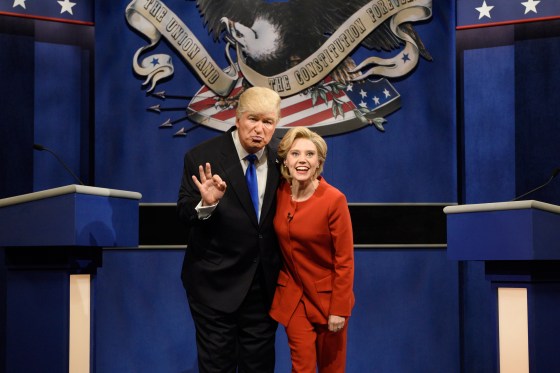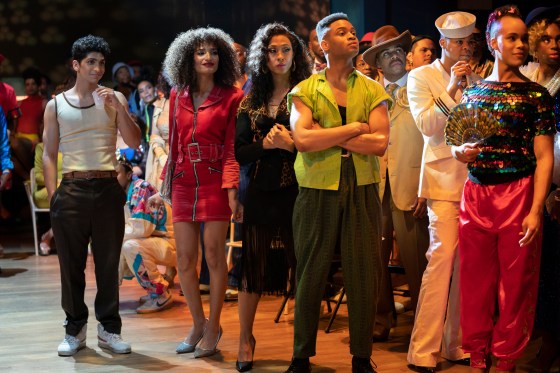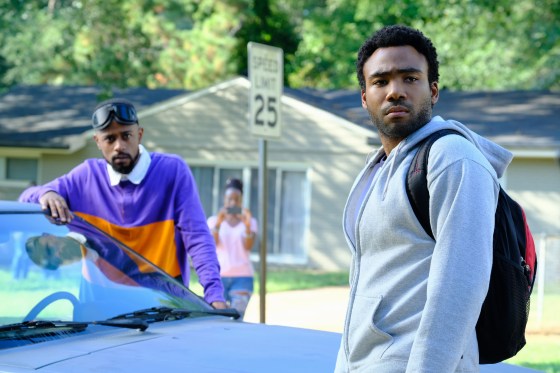Do you remember how it felt to be alive on November 9, 2016? If you spent the day in a big U.S. city—New York, Chicago, San Francisco—where overwhelmingly liberal masses lived crushed up against each other with no room to escape the ambient mood, you might never forget it: residents trudging around silent, sleepless, dead-eyed, as though something had siphoned off all their serotonin and then sent them on their way.
After the initial shock, conversations—in the media as well as in person—turned toward potential silver linings. Maybe those who smugly insisted America was “already great” would wake up to a more sobering reality. Maybe decent Republicans would join their Democratic colleagues in blocking the President-elect’s most extreme plans. And hey, wasn’t adversity supposed to be good for art? Certainly late-night comedians and punk bands would have plenty of fodder.
“They may not know it yet,” wrote New York magazine art critic Jerry Saltz, a few days after the election, “but Trump’s victory is a crucible of possibility for a new generation, who will do what artists have always done in times like these: go back to work.” The singer, songwriter and perennial controversy magnet Amanda Palmer weighed in from Australia, just before New Year’s, to double down on an earlier claim that “The Donald will indeed give us something to artistically push back against. dark times inspire, inflame and focus us as writers, artists and advocates.”
Not that there was much evidence to support this gallows optimism, even before the inauguration. Election-season pop culture had offered mostly cartoonish Trump effigies, the spectacle of Alec Baldwin mashing his lips together on SNL and Cheeto epithets sprinkled like so much orange dust. The Trump-is-ugly punchline had felt tired since at least August 2016, when activists placed life-size statues of the future President—nude, with a bulging stomach and tiny penis—in five cities. While the stated intention was to riff on “The Emperor’s New Clothes,” the project mostly succeeded in shaming anyone with a similar body. And the best protest song among dozens of contenders was YG and Nipsey Hussle’s bracingly blunt “FDT.” (If you know DT stands for Donald Trump, then you can probably guess which three letters come after the F.) You could argue that, for art, the first casualty of the Trump era was nuance.

It wouldn’t be the last. Over the last four years, the arts and entertainment have suffered mightily as Trump held court in the White House. While his policies have made it harder to subsist as a creative professional, his near-monopoly on the public sphere has distracted artists from their work and audiences from their engagement with it.
Put simply: Donald Trump was bad for art.
To begin with the obvious, Trump has lashed out at the arts and their practitioners. Since the 2016 election, the President has, usually via Twitter, attacked such entertainers as Meryl Streep, Robert De Niro and John Legend. In his capacity as self-appointed theater critic, he tarred Hamilton as “very overrated.” Every critical book or late-night joke at his expense or media company that didn’t bend to his will was called a failure.
More damaging, though less conducive to tabloid headlines and social media freakouts, have been his repeated attempts to defund already-strapped federal arts organizations such as the National Endowment for the Arts, the National Endowment for the Humanities, the Corporation for Public Broadcasting (which helps fund PBS and NPR) and the Institute of Museum and Library Services. Although these doomsday scenarios never came to pass, Trump’s rhetoric has intensified an enmity between the arts community and the right that dates back to Reagan-era censorship of transgressive artists including Robert Mapplethorpe and Karen Finley.
Trump’s agenda may have also indirectly endangered private arts funding, as progressives prioritized giving to explicitly political groups. A representative response to a 2017 survey by the California Association of Nonprofits: “We are already seeing a drop-off in general unrestricted donations in the range of $1-$500. These were primarily coming from younger working professionals that may be feeling economic uncertainty and/or are re-routing their giving away from arts organizations like ours to other organizations like ACLU, Planned Parenthood, etc.”
Then, three years into Trump’s term came the novel coronavirus—which, thanks in large part to his administration’s denial, neglect and disinformation surrounding the pandemic, has hit the U.S. shockingly hard. This ever-worsening crisis has created a nightmare for many workers and most sectors of the economy, but arts organizations and creative professionals have suffered disproportionately. In a report published in August by the Brookings Institution, Richard Florida and Michael Seman estimated the losses within creative industries since April at 2.7 million jobs and $150 billion. The picture was even more bleak for the fine and performing arts, with something like half of all jobs lost. Cities that bled money fighting the virus, even wealthy ones like New York, have made drastic cuts to their arts budgets. With museums closed or operating under intense restrictions, theaters empty, concert tours canceled, film and TV shoots delayed or canceled, whole art forms have gone dormant.
It seems obvious that, romantic notions about starving artists aside, fewer jobs and less funding would have an overall negative effect on a society’s creative output. But the emotional tenor of the Trump years hasn’t exactly been a gift to the arts, either. Shortly after the 2016 election, the author Porochista Khakpour told TIME: “For me, in times of emergency, it’s far more important to be an activist than artist.” While allowing that “those things don’t have to be at odds,” she explained that “we’re in an emergency situation right now. The urgency I feel—it’s very intense.” The time for writing and reflection would come later.
Meanwhile, a wildly accelerated news cycle eroded the concentration it takes to make good art. Anxiety and despair surrounding kids in cages or attacks on the Affordable Healthcare Act or escalating international tensions could torpedo the imagination. In early 2017, my Twitter feed filled up with artists of various kinds confessing that the work they’d always done suddenly felt gratuitous, if not impossible. Long before in-person workshops became a casualty of COVID, the informal fiction-writing group I’d started with a few friends became a forum for such handwringing, then tapered off into nothing.
Many creators found themselves compelled, for reasons of relevancy or moral obligation, to address the moment. “Either I don’t write at all or I write angry poems about some news item or Trump’s policies in general,” said poet Serena Agusto-Cox, summing up the responses of many peers as well, when the literary website Electric Literature surveyed writers about making art in the Trump era. And, as no single work exemplified more than Paul Rudnick’s Coastal Elites, a collection of anti-MAGA monologues written for the theater but diverted to HBO during the pandemic, it’s hard to carve out nuance when you’re wielding the blunt weapon of anger.
It’s not that we’ve been starved for good art since 2016; humanity simply makes too much of it to bear out such a broad generalization. And yet, the culture sphere has suffered from a Trump obsession fed by the President’s ubiquity, bombast and gleeful transgression of the norms that once made it possible for private citizens to forget about the federal government for full hours at a time. We got more ugly portraits, more half-baked impressions, more fake-tan jokes. TV invested in political polarization, offering an increasingly Resistance-flavored take on The Handmaid’s Tale, Sacha Baron Cohen’s Who Is America? and a short-lived Murphy Brown revival to some; SEAL Team, Live PD and a short-lived Roseanne revival to others. The specter of Trump has haunted superhero flicks from Spider-Man: Far From Home to Birds of Prey to Wonder Woman 1984. J.D. Vance’s controversial, best-selling 2016 memoir Hillbilly Elegy was treated as a Rosetta Stone for understanding Trump’s America; Ron Howard’s controversial, all-star Netflix adaptation bookended his tenure four years later. In August, the New York Times reported that more than 1,200 books about the President had already been published.

Even comedy—the medium so many expected to flourish under the 45th President—will emerge from the past several years in rough shape. Now that it’s impossible to satirize the daily absurdity of debates, hearings and press conferences, SNL casts famous faces in what are essentially reenactments. A subgenre that I think of as “explainer comedy” has taken off, exemplified by the didactic stylings of John Oliver, Hasan Minhaj and Hannah Gadsby. Broadcast network late-night hosts like Stephen Colbert and Jimmy Kimmel spent more time publicly lamenting Trump’s statements and policies than they did ridiculing them. One of the smartest, bravest political comedians of the Trump era, Michelle Wolf—who endured a surreal bipartisan backlash for telling real jokes at the 2018 White House Correspondents’ Dinner—skewered this trend in a Netflix talk show that was quickly canceled. In 2020, the comedy star of the moment is Sarah Cooper, who lip syncs Trump soundbites to underline the self-evident madness of, for example, suggesting COVID patients drink bleach.
Not all political art (and pretty much all art is political) has devolved. The Trump years have given us sharp satires of generational wealth: Succession, Knives Out, last year’s Best Picture winner Parasite (although it’s worth remembering that the latter is a product of the Korean film industry, not Hollywood). Television has expanded endlessly, making room for empathetic portraiture of the people who straight, white, capitalist society so often leaves behind: Pose, Vida, When They See Us, Watchmen, Immigration Nation, America to Me. Songs like Childish Gambino’s “This Is America” and albums like Lana Del Rey’s Norman F-cking Rockwell! sifted through the ashes of the American Dream. Consciously or otherwise, increasing mainstream enthusiasm for pop music from Latin America, Asia and Africa stood as a joyful retort to xenophobic policy. Startled out of institutional complacency by the “Muslim ban” that was one of Trump’s first acts as President, the Museum of Modern Art hung works by artists from the affected nations. My favorite novel of 2020 is Lydia Millet’s A Children’s Bible, which translates the anxiety of young people growing up on a planet threatened by inequality, authoritarianism and climate change—as well as the uselessness of their parents in the face of these crises—into the language of Judeo-Christian myth.

Yet so many of these works have roots that run deeper than Trump. It was the defining progressive movements of the past decade—Black Lives Matter, Occupy, marriage equality, an urgent wave of youth-led environmental activism, a transgender-rights movement that was more visible than ever before—that primed the culture for art that was antiracist, conservationist, critical of capitalist excesses, inclusive of all identities and experiences. Even #MeToo and the Women’s March, both of which responded to Trump’s mistreatment of women, stood on the shoulders of Obama-era pop feminism.
Think of all the indelible American political art that predated his presidency in the 2010s: Moonlight. Atlanta. Jane the Virgin. Lemonade. George Saunders’ Tenth of December. D’Angelo’s Black Messiah. Maggie Nelson’s The Argonauts. Kara Walker’s A Subtlety. Mitski’s “Your Best American Girl.” Selma. Orange Is the New Black. Jesmyn Ward’s Men We Reaped. Claudia Rankine’s Citizen. Nathan For You. Frank Ocean’s Blonde. Carol. American Crime Story. Paul Beatty’s The Sellout. Enlightened. Mad Max: Fury Road. Arthur Jafa’s Love Is the Message, the Message Is Death. Tangerine. Rachel Kushner’s The Flamethrowers. Three Run the Jewels albums. Mr. Robot. Chimamanda Ngozi Adichie’s Americanah. I Am Not Your Negro. The Leftovers. Kendrick Lamar’s To Pimp a Butterfly. And that’s just the beginning.

In his post-election polemic, New York’s Saltz predicted that regime change might “jar professionalized artists from being part and parcel of the career machine and return them and all of us to our rightful outsider gypsy position—aristocratic bohemians with highly calibrated bullsh-t detectors. After all,” he pointed out, “why should art want to serve consensus?” But when I look back at the major artworks of the Obama years, I see the opposite of consensus. The experiences and ideologies of the artists who flourished were just too diverse to be homogenous. And while some of the period’s most gleefully postracial output feels kind of naive now (e.g. Parks and Recreation and, yes, Hamilton), its creators didn’t seem in lockstep with the President so much as free to explore an unlimited range of topics, many of which had little to do with him.
Ironically, it’s the Trump years that have encouraged consensus art—art that, like Saltz’s reading of Obama-era culture, glosses over ideological differences within the broad categories of Democrat and Republican by speaking broadly to one half of the country or the other. A President who monopolizes the public’s attention with outrage after outrage possesses the power, it turns out, to shout down the individual creative voice or keep it stuck in a defensive crouch. Trump may have lit a fire under some artists, but the exhaustion, trauma and precarity that permeated his tenure worked hard to extinguish it.
We know that periods of social upheaval inform art, but that isn’t the same as nurturing it. The Renaissance was only possible after the Crusades. In Germany, the radical art of the Weimar Republic followed the devastation of World War I—and then disappeared, or worse, with the rise of Hitler. In the Global South, it was the end of colonial regimes that created space for master filmmakers like India’s Satyajit Ray and Senegal’s Ousmane Sembène. When the cultural sphere expands, when human beings have the mental and emotional energy to exercise their imaginations, when speech is free but not weaponized in the service of hate, when the range of perspectives that can be expressed in relative safety broadens—that is when art flourishes.
The transition will be neither instantaneous nor easy; as of November, 74 million American voters still supported Trump. COVID has already ensured that the early Biden years will be some of the toughest in our history, just as the Obama years were for many and every year is for some. No one’s granting left-leaning artists leave to go back to brunch, metaphorically speaking, if that’s where they ever were. It will take some time to shake the half-conscious psychological tics of making art in the age of Trump—to stop framing every work as a response to the President’s policies and stop projecting his personality on every fictional villain. But eventually, the Cheeto dust will dissipate and the view will start to clear.








0 comentários:
Post a Comment